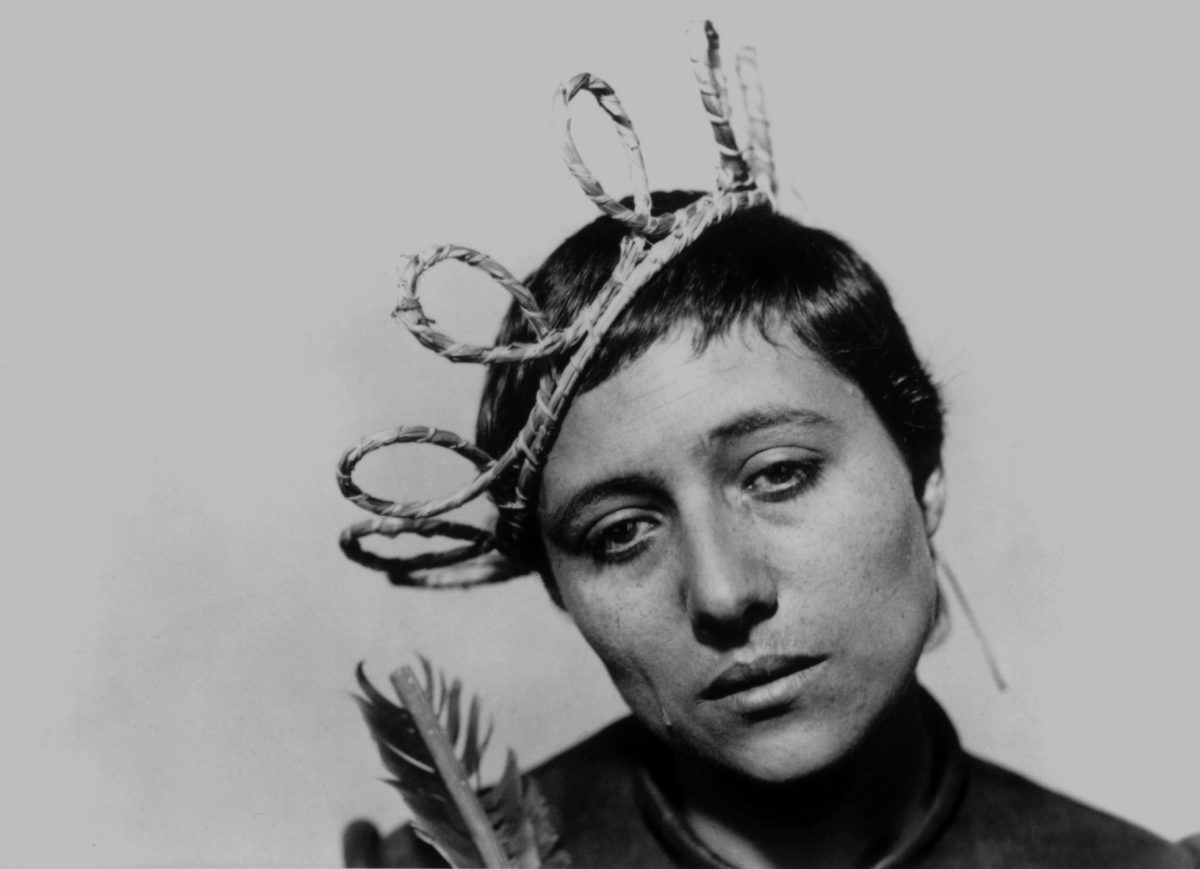
The following notes on The Passion of Joan of Arc were written by Nick Sansone, PhD student in Communication Arts at UW – Madison. The Passion of Joan of Arc will screen in a restored version scored to Richard Einhorn’s “Voices of Light” on Saturday, March 1, in the Cinematheque’s regular venue, 4070 Vilas Hall, 821 University Ave. Admission is free!
By Nick Sansone
Nearly a century after its release, Carl Theodor Dreyer’s The Passion of Joan of Arc continues to fascinate as both a historical retelling of Joan of Arc’s trial and martyrdom as well as one of the definitive artistic statements of cinema’s silent era. The film’s importance to any proper understanding of silent cinema has been well-argued over the years, with Roger Ebert writing in 1997 that “you cannot know the history of silent film unless you know the face of [the film’s star] Renée Maria Falconetti.” And indeed, together with F.W. Murnau’s Sunrise: A Song of Two Humans the year before, The Passion of Joan of Arc marked a sort of final statement of the silent era, showing how a series of close-up images and a highly emotional and evocative central performance could combine to create an impact that was hailed at the time as a masterpiece and continues to inspire filmmakers and scholars today.
The journey of The Passion of Joan of Arc to film really started eight years before its release, when the Roman Catholic Church canonized Joan of Arc as a saint. In the years leading up to her canonization, citizens of France had used her image to inspire victory for their country in World War I, and she soon became one of the patron saints of France. Seeing this resurgence in her popularity and having been invited to produce a film in France, director Dreyer relocated from his native Denmark to France, where he extensively researched Joan of Arc’s trial and eventually completed a screenplay drawn entirely from the historical record of her trial. While the actual trial lasted four-and-a-half months, Dreyer condensed it into the timeframe of a single day, which allowed for tight, limited plotting and increased the intensity of Joan’s ordeal.
To portray Joan of Arc going through this ordeal, Dreyer cast 35-year-old stage actress Renée Maria Falconetti after seeing her in a single play. Despite being nearly twice the age of the real Joan of Arc, Dreyer felt that she could bring forth the soul and sincerity and anguish that was at the heart of Joan
during this final part of her life. In constructing the film’s visuals and story around tight close-ups on Falconetti’s visage, he created a film that allowed her face and facial expressions to tell of Joan’s steadfast sacrificial commitment to both her Christian faith and belief in French independence. However, much controversy and contradictory stories have surfaced regarding the extent to which Dreyer mistreated or abused Falconetti on the set of the film to coax her pained performance. While various writers, including Ebert, have speculated that she was mistreated on set, many of these speculations were disputed by Dreyer biographers Jean and Dale Drum in their 2000 biography My Only Great Passion: The Life and Films of Carl Theodor Dreyer. The authors unearthed contemporary interviews with both Dreyer and Falconetti herself that refute rumors of Dreyer’s “sadistic” directorial methods and Falconetti herself described Dreyer as “the ideal director” and said she was “astonished at his industry, patience, and strength of will.” Nevertheless, Falconetti never appeared in another film (she had only appeared in one other film eleven years prior) and died eighteen years later at the age of 54.
The Passion of Joan of Arc received its world premiere in Denmark in early 1928, but was not screened in France for months due to edits demanded by the government and the Catholic Church that would censor the film’s depiction of religious hypocrisy. While Dreyer objected to these cuts, and subsequent attempts at censorship, he managed to cut together a second version of the film that used different takes than his original. Over the next several decades, many other versions of the film circulated in distribution, using different scores and even subtitles or narration to replace the original intertitles. Eventually by 1981, Dreyer’s original edit of the film prior to censorship, thought to have been lost forever in a vault fire, was found by a janitor at a Norwegian mental hospital. Upon delivery to the Norwegian Film Institute, the film was finally preserved as Dreyer originally intended, resulting in The Passion of Joan of Arc being able to be seen widely and theatrically in its original form.
Now, almost six centuries after she was burned at the stake at the age of nineteen, Joan of Arc continues to be the source of fascination amongst artists and storytellers, most recently inspiring two films by French filmmaker Bruno Dumont, as well as songs by artists ranging from Arcade Fire to Little Mix (even Chappell Roan dressed up as Joan of Arc for a recent televised performance of her song “Good Luck, Babe!”). In several ways, Dreyer’s singular vision of Joan of Arc as an anguished yet deeply faithful soul maintaining strength and Christlike devotion to her God and country remains the definitive depiction of the heroine on film, and perhaps the definitive statement of silent cinema’s power and possibilities just as it was about to become obsolete. The Passion of Joan of Arc’s unique combination of cinematography, direction, and iconic central performance is something that will never come close to being replicated again.